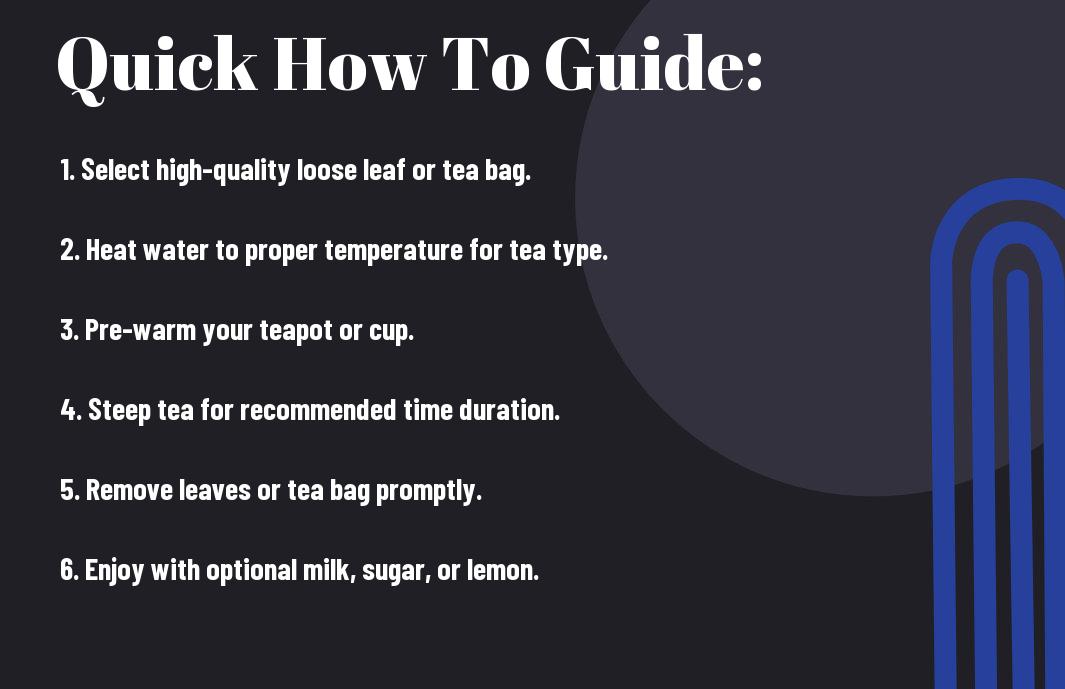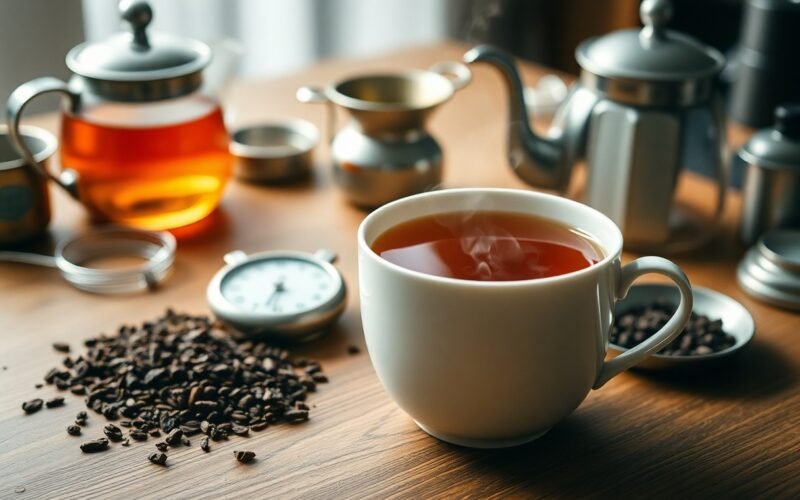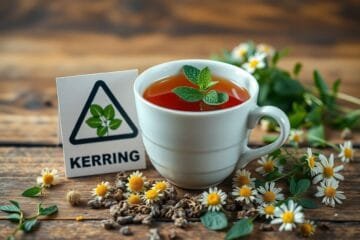You have the power to transform your tea experience with a few simple steps that guarantee a delicious brew. To achieve great flavor, it’s imperative to pay attention to water temperature and brewing time. Using the right type of tea leaves and letting them steep for the appropriate duration is key to unlocking all the rich notes and aromas. For best practices, check out this guide on how much time it takes to prepare 2 cups tasty tea. Let’s get started on your journey to creating the perfect cup!
Key Takeaways:
- Choose high-quality loose leaf tea for better flavor and aroma, paying attention to the type of tea you are brewing.
- Pay close attention to water temperature and steeping time, as these can significantly affect the taste of your tea.
- Use a proper tea-to-water ratio to balance the strength and flavor profile of your brewed tea.

The Science of Tea: Unlocking Flavor
The art of tea brewing is deeply rooted in science, influencing both flavor and aroma. Understanding how these elements interact can significantly elevate your brewing skills. Exploring the chemical compounds in tea leaves, such as catechins in green tea and theaflavins in black tea, reveals why different teas produce distinct tastes and effects. You can unlock the full potential of your tea by mastering the factors that contribute to its flavor profile, including type, temperature, and steeping time.
Understanding Tea Varieties: Black, Green, Herbal & More
Tea comes in a myriad of varieties, each offering unique characteristics. Black tea, known for its robust flavor, undergoes full oxidation, while green tea is minimally processed, preserving its fresh and grassy notes. Herbal teas, made from various plants and herbs, aren’t technically tea but still provide a rich tapestry of flavors. By learning about these varieties, you can better appreciate the diversity of tea and select the perfect type for your palate.
The Role of Temperature and Time in Extraction
Brewing tea isn’t just about following a simple recipe; it’s a delicate balance of temperature and steeping duration. Different teas require specific water temperatures for optimal flavor extraction. Black tea, for instance, brews best at 200-212°F, while green tea thrives at 160-180°F. Similarly, steeping times vary: 3-5 minutes for black tea and only 2-3 minutes for green tea. Understanding these parameters leads to a perfectly brewed cup every time.
Temperature and Time Guidelines
| Tea Type | Optimal Temperature & Steeping Time |
| Black Tea | 200-212°F, 3-5 minutes |
| Green Tea | 160-180°F, 2-3 minutes |
| Oolong Tea | 190-200°F, 3-5 minutes |
| White Tea | 160-185°F, 4-5 minutes |
| Herbal Tea | 200-212°F, 5-7 minutes |
Proper temperature and steeping times are necessary for maximizing the flavors in your tea. For instance, exceeding the steep time for green tea can result in bitterness due to excessive tannin extraction. Conversely, under-compensating can lead to a weak flavor, leaving you unfulfilled. By precisely calibrating your brewing parameters based on the tea type, you’ll not only achieve the perfect cup but also savor the intricate flavors that each variety has to offer.
Deep Dive into Flavor Extraction
| Tea Type | Flavor Profile Outcome |
| Black Tea | Bold and malty with a rich aroma |
| Green Tea | Bright, fresh, with vegetal notes |
| Oolong Tea | Floral and creamy, combining traits of black and green tea |
| White Tea | Delicate, light, with subtle sweetness |
| Herbal Tea | Varies widely based on ingredients, often fruit-forward or earthy |
The Essential Tools for Tea Mastery
Your journey to mastering tea brewing begins with the right tools. Investing in high-quality tea-making equipment can dramatically improve your brewing experience and enhance the flavor profile of your beloved tea. Essential items include a well-designed teapot, precision infusers, and an efficient water kettle. Each tool plays a significant role in the brewing process, unlocking the full potential of the tea leaves you choose. Familiarizing yourself with these necessarys will bring you one step closer to brewing the perfect cup each time.
Brewing Equipment: Teapots, Infusers, and Water Kettles
Quality matters when it comes to brewing equipment. A good teapot—ceramic, glass, or cast iron—ensures heat retention and even extraction of flavors. Choosing the right infuser allows for optimal water-to-leaf contact, which impacts the tea’s taste. Don’t underestimate the importance of a precise water kettle, as it helps you reach your desired temperature for different types of tea. Each of these tools brings individuality to your brewing process, allowing you to experiment with various teas and discover new favorites.
Water Quality: Why It Matters for the Perfect Brew
Tea brewing is as much about the water you use as it is about the tea itself. Using clean, filtered water devoid of impurities allows the true flavors of your tea leaves to shine through. The mineral content in water also influences the extraction process and overall taste; for instance, soft water is often preferable for delicate teas, while harder water can enhance bolder flavors. You might find that tap water can detract from your brew, so consider switching to high-quality bottled or filtered water to attain that perfect cup.
Water quality directly affects the brewing results in several notable ways. Hard water, rich in minerals like calcium and magnesium, can overpower delicate teas, while soft water may cause a flat taste in stronger blends. Conducting a simple taste test can illustrate this difference; brew the same tea with bottled spring water versus processed tap water, and you may well notice a significant taste discrepancy. Investing in a good water filtration system can ultimately transform your tea experience, elevating it to a new level of enjoyment.
Elevating Your Brew: Beyond the Basics
To truly elevate your tea experience, you can venture beyond the basic brew. Explore various types of tea, experiment with steeping times, and even try different temperatures for your water. Each choice dramatically alters the flavor profile, potentially leading to your new favorite cup. Consider exploring how how to make a perfect cup of Indian milk tea adds a delightful twist to your tea repertoire, combining rich flavors that ignite your taste buds.
Enhancing Flavor with Additives: Milk, Sweeteners, and Spices
Incorporating additives can transform your tea experience. Adding a splash of milk can create a creamy texture, while sweeteners like honey or agave bring out the natural flavors. Spices such as cardamom, cinnamon, or ginger infuse warmth, making your cup more aromatic. Pairing these elements not only enhances flavor but also makes for a more personalized drink that caters to your taste preferences.
Pairing Tea with Food: Creating the Ultimate Experience
Pairing tea with food is an art that can elevate any meal into a truly memorable dining experience. The right tea can enhance flavors, cleanse the palate, and create a harmonious balance. For instance, delicate green teas complement fresh salads and seafood, while robust black teas work beautifully with hearty dishes like roasted meats. Consider green tea with sushi for a refreshing contrast or bold chai with spicy Indian fare to highlight the dish’s complexities. Learning the nuances of tea-food pairings can make your culinary adventures much more exciting.
Engaging with the synergy between tea and food opens new avenues for your culinary experiences. For example, a crisp Darjeeling pairs wonderfully with light pastries, enhancing their sweetness with its floral notes. Conversely, you might find a strong Assam best served with savory items, as its malty richness contrasts beautifully with richer flavors. Each pairing can showcase the qualities of both the drink and the dish, making your meal not just enjoyable but a delightful exploration of flavor, aroma, and texture. Embrace the pairing adventure and discover where your palate takes you!
Troubleshooting Common Brew Mistakes
Even seasoned tea enthusiasts occasionally face mishaps during brewing. Factors such as water temperature, steeping time, and even the type of tea used can lead to flavors that are less than ideal. Understanding how to troubleshoot these common mistakes can transform your tea experience from average to extraordinary. Whether it’s bitterness from leaving your tea too long or a lackluster infusion due to understeeping, knowing how to adjust your brewing technique is key to achieving that flawless cup every time.
Oversteeping vs. Understeeping: Finding the Sweet Spot
Finding the perfect steeping time is vital to avoid the pitfalls of oversteeping or understeeping. Oversteeping often results in a bitter, astringent flavor, while understeeping can leave your tea weak and lacking depth. Different types of tea require different steeping times, so keep a close eye on the clock and taste along the way to discover your unique sweet spot.
Adjusting Proportions: How Small Changes Impact Flavor
A subtle shift in tea leaf quantity can significantly alter your brew’s character. Adjusting the amount of tea you use can enhance or mute specific flavor notes, giving you a lighter or more robust profile. For instance, using an extra half teaspoon can elevate the richness, while reducing the tea may yield a more delicate infusion. Experimentation is your ally for finding that ideal balance in proportion that gives you the perfect cup every time.
Adjusting proportions isn’t merely about increasing or decreasing the quantity of tea leaves. It involves understanding the unique qualities of your tea. For example, green teas often require less leaf per cup than black teas due to their more delicate flavors. If you’re brewing a floral oolong, try adding just a pinch more to enhance those fragrant notes. On the other hand, for robust black teas, adding a bit less can mitigate bitterness. Keep a brew journal to note your adjustments and their effects; this will lead you to your desired flavor profile consistently.
Expert Tips from Teas Around the World
Exploring tea traditions across the globe can elevate your brewing game. For instance, in Japan, the art of matcha is celebrated for its ceremonial significance. Emphasizing quality, you’d want to use a fine matcha powder and a bamboo whisk to create a frothy, vibrant cup. In Morocco, the mint tea ritual involves repeatedly pouring hot water from a height to aerate the tea, creating a refreshing blend. Each region adds its unique flair to the experience, making your tea journey ever richer. Thou will discover a world full of flavor and tradition!
Cultural Traditions: Brewing Tea Like a Local
To truly savor tea like a local, immerse yourself in regional practices. In China, gongfu brewing demands attention to time and temperature, often using multiple infusions of leaves. Adjust your brewing techniques based on local customs; for instance, British afternoon tea pairs black tea with milk and scones. You’ll not only enjoy the drink itself but also gain insight into the culture behind it. What’s a brewing routine without the local flair, right?
Mastering Seasonal Brews: Adapting to Climate and Mood
Adapting your tea choices based on the season enhances both flavor and experience. During warmer months, refreshing blends with iced tea or herbal infusions can be invigorating, while in the colder months, comforting chai or spiced teas warm your soul. Consider the available herbs, fruits, or spices in your area, making seasonal concoctions that align with your mood. The versatility of tea allows you to be creative and intentional in your brewing.
In summer, enjoy cooling teas like hibiscus or peach iced tea, which help quench your thirst while providing a touch of sweetness. For chilly winter days, a warming masala chai spiced with ginger and cinnamon can lift your spirits. Experimenting with flavors based on seasonal ingredients not only enhances your appreciation for tea but can tailor your drinking experience to reflect the unique ambiance of each season. Thou will find joy in a cup that resonates with the world around you.
Conclusion
Upon reflecting, you now have the imperative steps to brew the perfect cup of tea every time. By paying attention to water temperature, steeping times, and the quality of your tea leaves, you can elevate your tea experience significantly. Whether you prefer robust black tea or delicate green tea, these guidelines will help you refine your technique and impress your taste buds. Embrace the ritual and enjoy the soothing process of making your ideal cup of tea.
FAQ
Q: What type of water should I use to brew tea for the best flavor?
A: The quality of water can significantly affect the taste of your tea. It is recommended to use fresh, filtered water rather than tap water, which may contain chlorine or other minerals that can alter the flavor. Ideally, use spring water or filtered water, as it allows the true flavors and aromas of the tea to shine. If you’re not using bottled water, let tap water sit for a few hours to allow any chlorine to dissipate before using it for brewing.
Q: How do I determine the right steeping time and temperature for my tea?
A: The steeping time and water temperature depend on the type of tea you are brewing. Generally, black tea is steeped at 200-212°F (93-100°C) for 3-5 minutes, green tea at 170-185°F (77-85°C) for 2-3 minutes, and herbal tea can be steeped at boiling point (212°F or 100°C) for 5-7 minutes. Always check the tea packaging for specific instructions, as different brands and blends may have tailored recommendations. Using a thermometer can help ensure consistent water temperature for optimal flavor extraction.
Q: How can I enhance the flavor of my tea without adding sweeteners?
A: There are several natural ways to enhance the flavor of your tea without resorting to sugar or artificial sweeteners. You can add fresh herbs such as mint or basil, or a slice of lemon or orange for a citrusy kick. Spices like cinnamon or ginger can also infuse your tea with warmth and depth. If you’re brewing green tea, consider adding a small amount of honey or a splash of vanilla for a unique twist. Experimenting with different flavors will allow you to discover your perfect cup while keeping it healthy!




